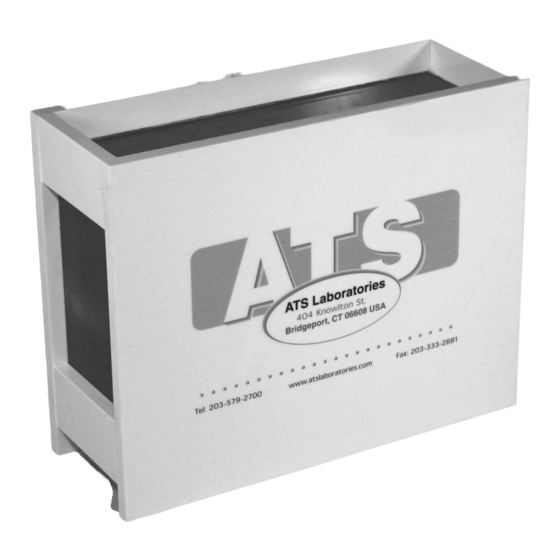ATS 570 Gebrauchsanweisung - Seite 10
Blättern Sie online oder laden Sie pdf Gebrauchsanweisung für Laborausrüstung ATS 570 herunter. ATS 570 13 Seiten. Multipurpose - endoscopic phantom

These artifacts can be the result of transducer malfunction, poor electrical contacts, failure in the image
processing and/or system's software, and poor acoustic coupling between the transducer/patient interface
causing the introduction of reverberations artifacts. Generally, horizontal bands are often caused by circuitry and
focusing problems while vertical bands indicate a damaged transducer element.
Testing Procedure
1. Position the transducer over the anechoic target structures until a clear image is obtained.
2. Freeze image and obtain a hard copy.
3. Examine the image to determine the first and last target in each size group displayed. Record the
range of depths visualized for each group. Due to the configuration of the sound beam small targets
in the near field may not be imaged.
4. Scan this region to determine if there are any areas of non-uniformity. If the initial image
demonstrates non-uniformity or artifacts of this type, repeat the scan at a different location using the
same phantom to rule out a defect in a particular region of the phantom. If the artifacts are still
present, note the gain settings, gray scale level and focal setting and document with a photograph.
Repeat the scan using a different gain and focal setting.
5. Document all findings on the quality assurance record.
Results
The system's functional resolution and image uniformity should remain consistent from week to week when using
the same instrument settings and Model 570 phantom. Compare the test results obtained from the baseline
records. If the current image demonstrates changes in the system's ability to resolve these targets, or major
areas of image non-uniformity are observed, corrective action should be considered.
GRAY SCALE & DISPLAYED DYNAMIC RANGE
Description and Reason For Testing
Gray scale or gray scale processing uses the amplitude of the echoes received to vary the degree of brightness
of the displayed image. The adjustment of the echo signal required to go from a just noticeable (lowest gray
scale level) echo to the maximum echo brightness is referred to as the displayed dynamic range. Clinically, gray
scale processing and displayed dynamic range allow echoes of varying degrees of amplitude to be displayed in
the same image.
Test Procedure
1. Position the transducer over the gray scale target group until a clear image is obtained.
2. Freeze image and obtain a hard copy.
3. Examine the image. The targets should appear circular in shape, with clear sharp edges and vary in
the degree of brightness ranging from low to high levels of contrast. The presence or absence of any
shadowing behind the structures should be noted.
4. All findings should be documented on the quality assurance record.
Results
This target group varies in echogenicity and provides a good indication of the performance of the gray scale
processing and displayed dynamic range. The system's gray scale processing should remain consistent from
week to week when using the same instrument settings and Model 570 phantom. Compare the test results
obtained from the baseline records. If the current image demonstrates changes in the system's ability to resolve
these targets, corrective action should be considered.
General References:
Michell M. Goodsitt, Paul Carson; "Real-Time B-mode Ultrasound Quality Control Test Procedures, Report of
AAPM Ultrasound Task Group No. 1," Medical Physics, 25 (8) August 1998
W.
N. McDicken, PhD, "Diagnostic Ultrasonics, Principles and Use of Instruments," John Wiley & Sons, 1976.
Sandra L. Hagen-Ansert; "Textbook of Diagnostic Ultrasonography," Mosby, 1989.
10
